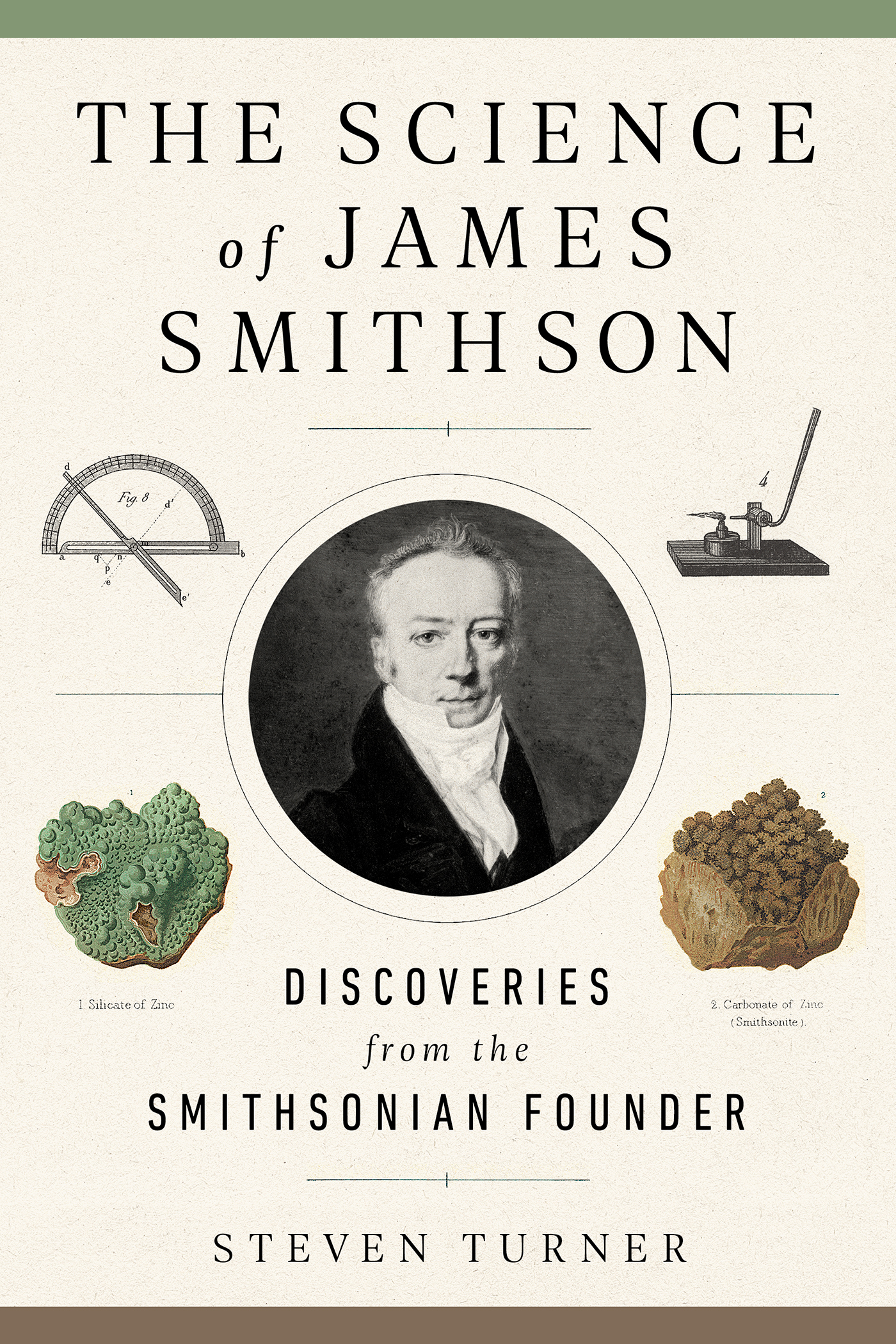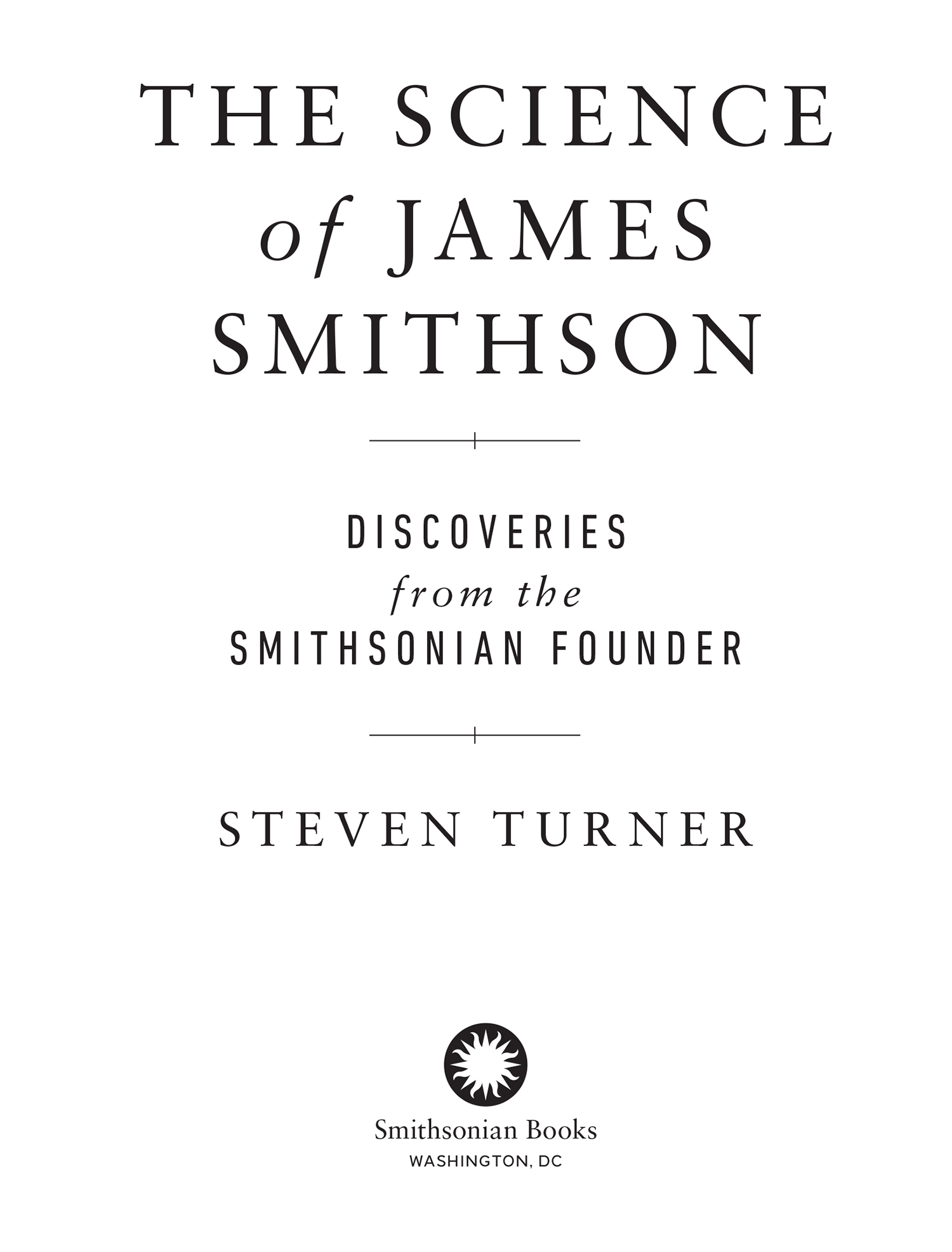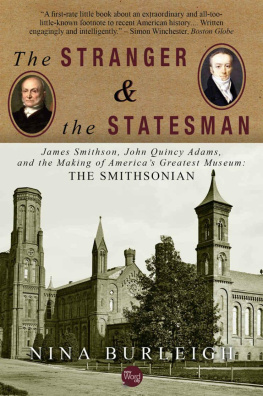Steven Turner - The Science of James Smithson: Discoveries from the Smithsonian Founder
Here you can read online Steven Turner - The Science of James Smithson: Discoveries from the Smithsonian Founder full text of the book (entire story) in english for free. Download pdf and epub, get meaning, cover and reviews about this ebook. year: 2020, publisher: Smithsonian, genre: Detective and thriller. Description of the work, (preface) as well as reviews are available. Best literature library LitArk.com created for fans of good reading and offers a wide selection of genres:
Romance novel
Science fiction
Adventure
Detective
Science
History
Home and family
Prose
Art
Politics
Computer
Non-fiction
Religion
Business
Children
Humor
Choose a favorite category and find really read worthwhile books. Enjoy immersion in the world of imagination, feel the emotions of the characters or learn something new for yourself, make an fascinating discovery.
- Book:The Science of James Smithson: Discoveries from the Smithsonian Founder
- Author:
- Publisher:Smithsonian
- Genre:
- Year:2020
- Rating:4 / 5
- Favourites:Add to favourites
- Your mark:
- 80
- 1
- 2
- 3
- 4
- 5
The Science of James Smithson: Discoveries from the Smithsonian Founder: summary, description and annotation
We offer to read an annotation, description, summary or preface (depends on what the author of the book "The Science of James Smithson: Discoveries from the Smithsonian Founder" wrote himself). If you haven't found the necessary information about the book — write in the comments, we will try to find it.
The Science of James Smithson: Discoveries from the Smithsonian Founder — read online for free the complete book (whole text) full work
Below is the text of the book, divided by pages. System saving the place of the last page read, allows you to conveniently read the book "The Science of James Smithson: Discoveries from the Smithsonian Founder" online for free, without having to search again every time where you left off. Put a bookmark, and you can go to the page where you finished reading at any time.
Font size:
Interval:
Bookmark:


2020 by Steven Turner and the Smithsonian Institution
All rights reserved. No part of this publication may be reproduced or transmitted in any form or by any means, electronic or mechanical, including photocopying, recording, or information storage or retrieval system, without permission in writing from the publishers.
Funding for this book was provided in part by Smithsonian Institution Scholarly Press
Published by Smithsonian Books
Director: Carolyn Gleason
Senior Editor: Jaime Schwender
Assistant Editor: Julie Huggins
Edited by Gregory McNamee
Cover design by Pete Garceau
Book design by Gary Tooth, adapted for ebook
This book may be purchased for educational, business, or sales promotional use. For information, please write: Special Markets Department, Smithsonian Books, P.O. Box 37012, MRC 513, Washington, DC 20013
Library of Congress Cataloging-in-Publication Data
Names: Turner, Steven, author.
Title: The science of James Smithson : discoveries from the Smithsonian founder / Steven Turner.
Description: Washington, DC : Smithsonian Books, [2020] | Includes bibliographical references and index. | Summary: An exploration of the scientific career of James Smithson, who left his fortune to establish the Smithsonian InstitutionProvided by publisher.
Identifiers: LCCN 2020017952 (print) | LCCN 2020017953 (ebook) | ISBN 9781588346902 (hardcover) | ISBN 9781588346933 (epub)
Subjects: LCSH: Smithson, James, 1765-1829. | Smithsonian InstitutionHistory. | ScientistsGreat BritainBiography.
Classification: LCC Q143.S6 T87 2020 (print) | LCC Q143.S6 (ebook) | DDC 509.2 [B]dc23
LC record available at https://lccn.loc.gov/2020017952
LC ebook record available at https://lccn.loc.gov/2020017953
For permission to reproduce illustrations appearing in this book, please correspond directly with the owners of the works. Smithsonian Books does not retain reproduction rights for these images individually or maintain a file of addresses for sources.
Ebook ISBN9781588346933
a_prh_5.6.0_c0_r0
For Ikuko
The Long Road to Staffa
Edinburgh, London, and Paris
Tabasheer
Calamine
Minium
The Sulphuret from Huel Boys
On the Composition of Zeolite
Ulmin
A Saline Substance from Mount Vesuvius
The Colouring Matters of Some Vegetables
A Sulphuret of Lead and Arsenic, and Plomb Gomme
Fibrous Copper and Capillary Metallic Tin
Sulphate of Barium and Fluoride of Calcium
A New Test for Arsenic and Smithsons Pile
Smithsons Lamp and the Sappare
An Aristocratic Science Dabbler?
Chloride of Potassium
Compounds of Fluorine
Egyptian Colors
Kirkdale Cave and Penns Theory
The Increase and Diffusion of Knowledge

W HO WAS J AMES S MITHSON ? That question has been asked since the 1830s, when a little-known Englishman left his fortune, as his will specified, to the United States of America, to found at Washington, under the name of the Smithsonian Institution, an establishment for the increase and diffusion of knowledge among men.
This was not Smithsons first choice. He initially left the estate to his nephew, who controlled it until that nephew died in 1835, after which it was then supposed to go to his heirs. But the nephew had been childless, and in that case the will, in its very last clause, required the money go to the United States.
Smithson had not talked to anyone about this, and the phrase an establishment for the increase and diffusion of knowledge among men served as the only instructions he ever gave for how the money should be used. In 1838, when Smithsons estate arrived in New York harbor, it consisted of his clothes and personal possessions, his papers, scientific instruments, and extensive mineral collection, and several boxes of gold coins. The coins were promptly melted down and reminted into $508,318.46 in US currencyabout 1.5 percent of the entire federal budget at the time. It was an enormous sum, and it took Congress almost eight years to decide what to do with it. Eventually Congress decided to honor Smithsons request, and in 1846 the funds were used to found the Smithsonian Institution, the vast museum complex whose buildings now line the National Mall in Washington, DC.
The Smithsonian thrived and grew, but there was always a desire within the institution to learn more about its founder. Smithson was known to have been a man of science, but beyond that little was known about him. The Smithsonian Annual Report for 1857 announced that a list of the papers published by Smithson, and a record of all the facts which could be gathered in relation to him, have been made, to serve hereafter for a more definite account of his life and labors than has yet appeared. That project was not yet completed when a fire that ravaged the Smithsonian Castle in 1865 destroyed most of Smithsons papers and all of his artifactsincluding his huge mineral collection.
The Smithsonian Castle was rebuilt, and in 1879, to commemorate the fiftieth anniversary of Smithsons death, the institution made another attempt to reconstruct its founders history. Requests for information were posted in major American newspapers and journals and privately circulated in England.
Around the same time, an effort was made to understand Smithsons science and identify his scientific articles. Twenty-seven published scientific articles were found and subsequently reprinted in The Scientific Writings of James Smithson (1879). Along with the articles, this commemorative volume also included two reviews of Smithsons scientific character. One had been written by American chemist Walter R. Johnson in 1844, and the other was a newly commissioned work by twenty-five-year-old American mineralogist John Robin McDaniel Irby. Johnsons review was primarily factual, but Irbys expressed an opinion that would become the standard assessment of Smithson for the next century. He wrote:
We could wish Smithsons name to have been coupled with some great discovery, or with the apprehension of some far-reaching law that would have formed a worthy inscription for the portal of his institution. Though this be not gratified, we shall find that he appreciated the great problems before him and attempted their solution; that he knocked earnestly and worthily at the portal of great knowledge, and that although it was denied him to be the first to enter into the greater chambers, he was, nevertheless, no unworthy seeker.
This conclusion and its unspoken sense of disappointment set the tone for all subsequent assessments of Smithsons work. Even within the Smithsonian, the view was taken that although Smithson had been dedicated and hardworking, he had been little more than a scientific dabbler or a second-tier figure.
In 1904, Samuel Langley, the Smithsonian secretary, wrote in the Scientific American Supplement that Smithson is not to be classed among the leaders of scientific thought; but his ability and the usefulness of his contributions to knowledge, cannot be doubted. Twenty-five years later, on the centenary of Smithsons death, no one in the Smithsonian objected when the respected journal
Font size:
Interval:
Bookmark:
Similar books «The Science of James Smithson: Discoveries from the Smithsonian Founder»
Look at similar books to The Science of James Smithson: Discoveries from the Smithsonian Founder. We have selected literature similar in name and meaning in the hope of providing readers with more options to find new, interesting, not yet read works.
Discussion, reviews of the book The Science of James Smithson: Discoveries from the Smithsonian Founder and just readers' own opinions. Leave your comments, write what you think about the work, its meaning or the main characters. Specify what exactly you liked and what you didn't like, and why you think so.









